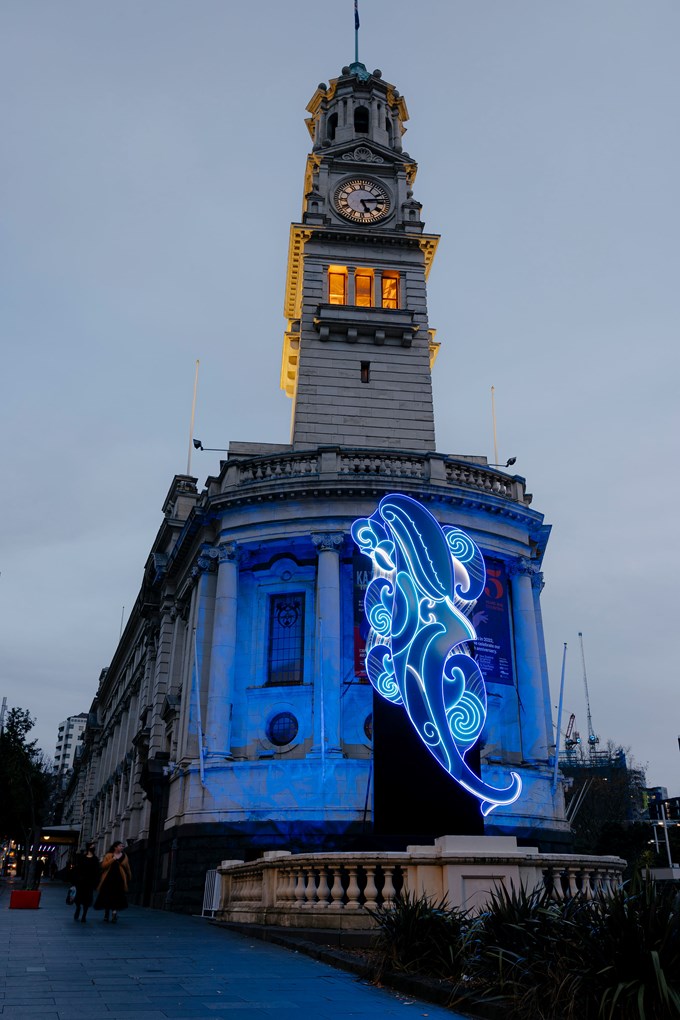Tūrama
From the karanga of Hape welcoming early waka voyagers to the open invitation from Ngāti Whātua Ōrākei to William Hobson to establish the settlement of Auckland in 1840, to becoming the beating heart of contemporary Tāmaki Makaurau, the Waihorotiu valley has always been a place renowned for the extension of manaakitanga, for welcoming and extending hospitality to visitors, to guests and to ourselves.
The ancient citadels Te Ngahuwera, Te Rerengaoraiti and Te Horo Roa standing above, the bountiful Wai o Horotiu river flowing along the valley floor to meet Te Waitematā, the abundant ngahere of the valley teeming with life and song, the generations upon generations of footprints left by Mana Whenua over the millenia; all part of a native and natural landscape now lost beneath the modern city centre’s urban form, removed from our sight.
But not from our memories. Or our future.
Tūrama is an open invitation to all of Tāmaki Makaurau to revisit and re-imagine the Waihorotiu valley. You will celebrate art works by icons of Māori art and design, meet the manu (birds) of this place, and come face to face with a 9-metre-high representation of resident kaitiaki Horotiu.
Prepare to be amazed at the celebration of light, form, scale and life that has been developed for Tūrama by the creative team of Graham Tipene (Ngāti Whātua Ōrākei, Ngāti Kahu, Ngāti Hine, Ngāti Haua, Ngāti Manu), Ataahua Papa (Ngāti Korokī Kahukura, Ngāti Mahuta) and Angus Muir Design.
Te Kaunihera o Tāmaki Makaurau (Auckland Council) and Ngāti Whātua Ōrākei are proud to bring Tūrama and the Wai Horotiu valley to life as part of Matariki ki te Manawa, for all of Tāmaki Makaurau to enjoy.
Horotiu
He tupua, he taniwha, he kaitiaki
Wai o Horotiu is the ancestral river that once flowed through what is now the Queen Street valley. The river sustained and enabled settlement of this area over the millenia, and the valley is literally thick with ngā tapuwae o ngā mana o te whenua (the footprints of local tribes), embedded into this space over time, testament to the richness of local resources and strategic importance of this location.
Alongside these tūpuna (ancestors), this valley and its river were also the domain of Horotiu, a being of both physical and metaphysical dimensions. Horotiu is recognised variously by Mana Whenua as kaitiaki of this area, and also as taniwha (fabulous monster) within this, his domain; an enduring influence to remind us, and to challenge us.
Despite the historic covering over and containment of Wai o Horotiu, this river still flows and dances beneath our feet, and retains both mana and mauri, albeit compromised significantly by our contemporary urban form and lifestyles.
For Ngāti Whātua Ōrākei, having Horotiu stand in this place in this way is a powerful and poignant challenge to us all to consider the health and wellbeing of our urban waterways and water systems, as plans for the development of Tāmaki Makaurau continue. Continuing to tell the many stories of this place, broadening understanding and ensuring the education of the many generations ahead of us who will inhabit the legacies we are creating through our actions remain ongoing and important challenges for us all.
The whenua now occupied by the Auckland Town Hall was once a kāinga (settlement site). Development of this space uncovered koiwi (human remains). The resting place of these tūpuna was disrupted, requiring them to be uplifted and reinterred elsewhere to enable construction. Horotiu in this place prompts us to remember the sacrifice of those who have shaped this place for all Aucklanders and whose memory we should acknowledge into the future.
Horotiu is a collaboration between Graham Tipene (Ngāti Whātua Ōrākei, Ngāti Kahu, Ngāti Hine, Ngāti Haua, Ngāti Manu), Ataahua Papa (Ngāti Korokī Kahukura, Ngāti Mahuta) and Angus Muir Design.


